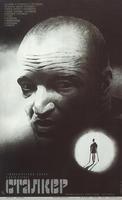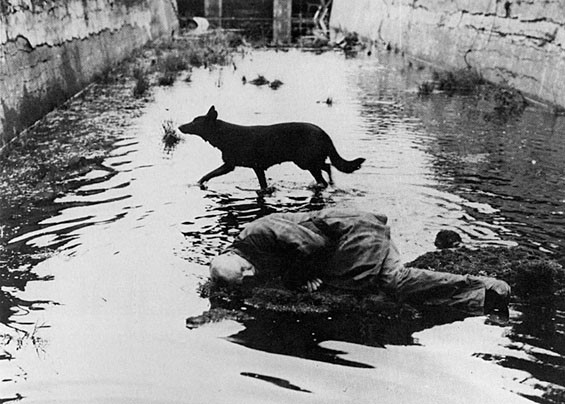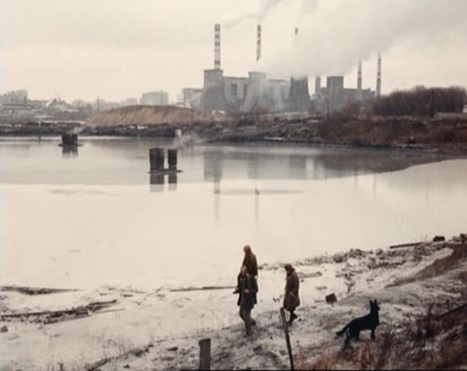

Andrei Tarkovsky’s science-fiction film, Stalker (1979), is marked by depression, desolation and barren wastelands.[1] The film’s loose narrative follows three men into The Zone, a disturbingly conscious and supernatural area of nuclear disaster. Whilst there, the eponymous Stalker encounters a black dog at various points on the journey. As the Stalker waits for his wife in the bar, having just left The Zone, we see the dog has joined them. He sits obediently as the Stalker feeds him some meat. The Stalker says: ‘He got attached to me. I couldn’t leave him there’. Notably, the Stalker says the dog became attached to him, not the other way round, but his feeling that he ‘couldn’t’ leave without him suggests the bond is, to a certain degree, reciprocal. This attachment is one of the rarest glimmers of spiritual communion or connection amongst characters in the film. It is made all the more distinctive by the fact it is between a human and a dog.
Through one long take, Tarkovsky encapsulates a newfound relationship between the Stalker’s family and the dog (see fig.2). Having now left the bar, the family walk away from the town towards home. The shot begins as a close-up of the daughter’s profile, moving slowly and solemnly to the right. As the shot continues, the camera pulls back into a long shot that shows the daughter, paralysed from the waist down, is being carried by her father on his shoulders, as the mother and the dog follow. The family now occupy the foreground and the lower-third of the frame. A nearly frozen lake and a dreary, ominous power station are situated in the middle-ground and background respectively. As the family walk silently, downtrodden and gloomy through the snow, the dog energetically runs about them. For brief moments at a time the dog is in front of them, then behind them; above them on the hill and then below them on the hill; he is constantly circling them and looking in every direction. The dog’s exertion of energy, to the point of appearing playful, markedly contrasts the family and heavy tone of the film. Despite this, the dog is ultimately moving with the direction of the family. His erratic, energetic movement is, therefore, not a depiction of the dog as wild and natural, in opposition to the human family. Rather, the dog is acting like a caring companion and watchful guardian to the family, displaying characteristics of obedience and domestication. After seemingly inhabiting the haunting isolation of The Zone until now, the dog appears to be desiring and finding pleasure in human companionship. However, the dog has done so without apparent command, order or control from a human. His immediate obedience and attachment to the humans paradoxically presents this behaviour as instinctive. The dog occupies a liminal space between wild and domestic and thus creates an ambiguous tension between the different ways humankind has an effect on the world. On the one hand, the dog playfully inhabits the role of “man’s best friend”, acting as companion and guardian. However, as this shot encapsulates, he has been subjected to the devastating effects of nuclear disaster, left behind and alone until now.

[1] Stalker. Dir. Andrei Tarkovsky. Mosfilm. 1979.